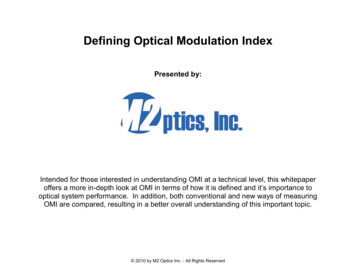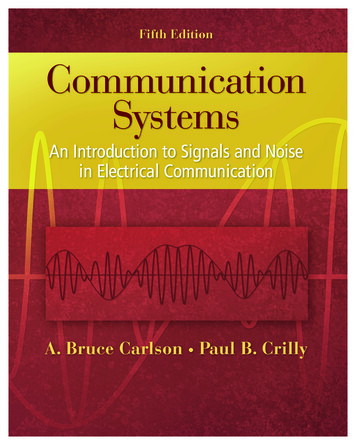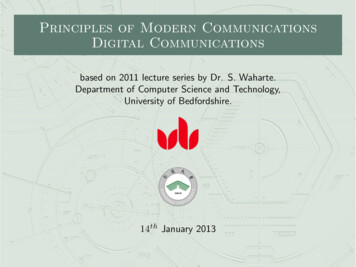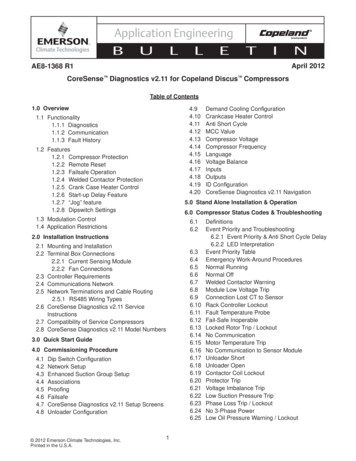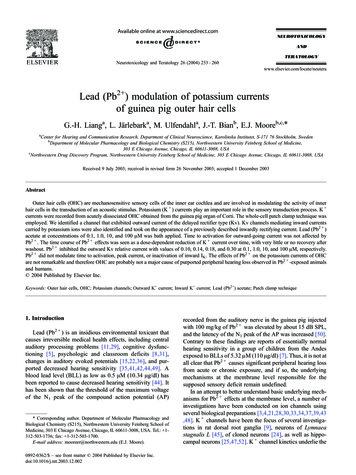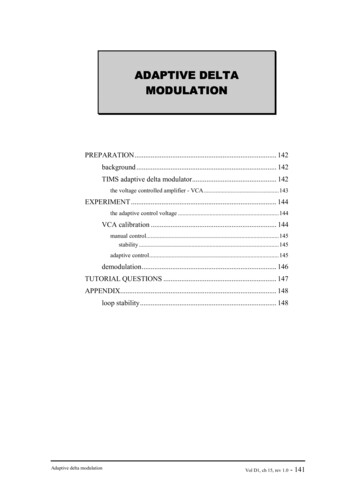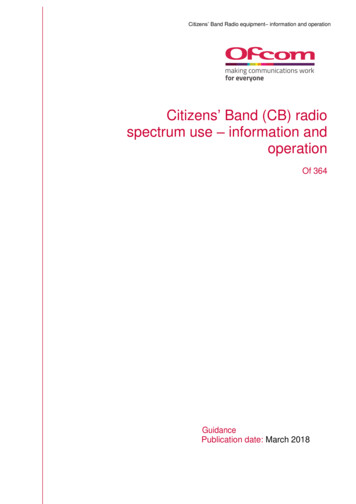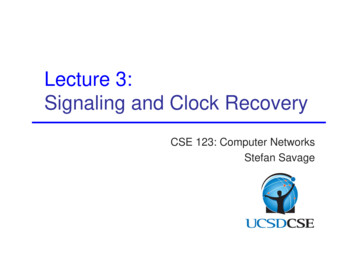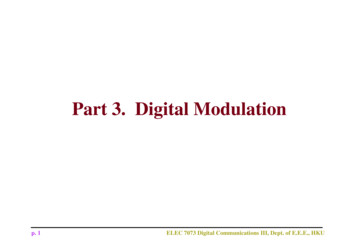
Transcription
Part 3. Digital Modulationp. 1ELEC 7073 Digital Communications III, Dept. of E.E.E., HKU
What’s Modulation & Demodulation?¾ Digital modulation and demodulation:– Modulation (demodulation) maps (retrieves) the digitalinformation into (from) an analog waveform appropriatefor transmission over the channel.– Generally involve translating (recovering) the basebanddigital information to (from) a bandpass analog signal ata carrier frequency that is very high compared to thebaseband frequency.– Examples: ASK, FSK, QPSK, 16QAMp. 2ELEC 7073 Digital Communications III, Dept. of E.E.E., HKU
Modulation & DemodulationCarrierBasebandModulationData inp. ion/DecisionData outELEC 7073 Digital Communications III, Dept. of E.E.E., HKU
Why Carrier?¾ Effective radiation of electromagnetic wavesrequires antenna dimensions comparable with thesignal’s wavelength:– Antenna for 3 kHz carrier would be 100 km long– Antenna for 3 GHz carrier is 10 cm long¾ Frequency division multiplexing Shifting the baseband signals to different carrierfrequencies Sharing the communication channel resourcesp. 4ELEC 7073 Digital Communications III, Dept. of E.E.E., HKU
Geometric Representation (1)¾ Digital modulation involves choosing a particularanalog signal waveform si(t) from a finite set S ofpossible signal waveforms based on the informationbits applied to the modulator.¾ For binary modulation schemes, a binary informationbit is mapped directly to a signal and S contains only 2signals, representing 0 and 1.¾ For M-ary modulations, S contains more than 2 signalsand each represents more than a single bit ofinformation. With a signal set of size M, it is possibleto transmit up to log2M bits per signal.p. 5ELEC 7073 Digital Communications III, Dept. of E.E.E., HKU
Geometric Representation (2)¾ Any element of set S, S {s1(t), s2(t), , sM(t)}, canbe represented as a point in a vector space whosecoordinates are basis signals φj(t), j 1,2, ,N, suchthat φ ( t ) φ ( t ) dt 0, i j; ( orthogonal)ij E φ ( t ) i2dt 1; ( normalization) si ( t ) can be represented as a linear combination of the basis signals.Nsi ( t ) sijφ j ( t ) , i 1, 2,,Mj 1p. 6ELEC 7073 Digital Communications III, Dept. of E.E.E., HKU
Example: BPSK Geometric Representation 2 Ebcos ( 2π f c t θ c ) , s1 ( t ) Tb S BPSK 2 Eb st cos ( 2π f c t θ c ) ; 2 ( )Tb Eb energy per bit; Tb bit period ; 0 t Tb For this signal set, there is a single basis signalφ1 ( t ) S BPSK{2cos ( 2π f c t θ c ) ; 0 t TbTb} Eb φ1 ( t ) , Eb φ1 ( t ) - EbQ EbIConstellation diagramp. 7ELEC 7073 Digital Communications III, Dept. of E.E.E., HKU
Constellation Diagram¾ A graphical representation of the complex envelope ofeach possible signal¾ The x-axis represents the in-phase component and they-axis represents the quadrature component of thecomplex envelope¾ The distance between signals on a constellationdiagram relates to how different the modulationwaveforms are and how well a receiver candifferentiate between them when random noise ispresent.p. 8ELEC 7073 Digital Communications III, Dept. of E.E.E., HKU
Performance Measures (1)¾ Two key performance measures of a modulationscheme are power efficiency and bandwidth efficiency¾ Power efficiency is a measure of how favorably thetradeoff between fidelity and signal power is made, andis expressed as the ratio of the signal energy per bit(Eb) to the noise PSD (N0) required to achieve a givenprobability of error (say 10 5):Ebηp N0p. 9Small η p is preferredELEC 7073 Digital Communications III, Dept. of E.E.E., HKU
Performance Measures (2)¾ Bandwidth efficiency describes the ability of amodulation scheme to accommodate data within alimited bandwidth, In general, it is defined as the ratioof the data bit rate R to the required RF bandwidth B:RηB (bps/Hz)BLarge ηB is preferred¾ Channel capacity gives an upper bound of achievablebandwidth efficiency:ηB maxp. 10CS log 2 (1 )BNELEC 7073 Digital Communications III, Dept. of E.E.E., HKU
Modulation Schemes Classification¾ Linear modulation: the amplitude of the transmittedsignal, s(t), varies linearly with the modulating digitalsignal, m(t). Bandwidth efficient but power inefficient Example: ASK, QPSK¾ Nonlinear modulation: the amplitude of thetransmitted signal, s(t), does not vary linearly with themodulating digital signal– Power efficient but bandwidth inefficient– Example: FSK, constant envelope modulationp. 11ELEC 7073 Digital Communications III, Dept. of E.E.E., HKU
Demodulation (1)¾ Coherent demodulation: requires a replica carrierwave of the same frequency and phase at the receiver The received signal and replica carrier are cross-correlated Also known as synchronous demodulation Carrier recovery methods Using PLL to recover the carrier phase and frequency from thetransmitted pilot carrier signal, Recovering the carrier from the received signals using costasloop– Applicable to: PSK, FSK, ASK, etc.p. 12ELEC 7073 Digital Communications III, Dept. of E.E.E., HKU
Demodulation (2)¾ Example of BPSK coherent demodulator:p. 13CarrierrecoveryELEC 7073 Digital Communications III, Dept. of E.E.E., HKU
Demodulation (3)¾ Non-coherent demodulation: does not require areference carrier wave– It is less complex than coherent demodulation (easier toimplement), but has worse performance– Applicable to: DPSK, FSK, etc.– Example: FSK non-coherent demodulatorp. 14ELEC 7073 Digital Communications III, Dept. of E.E.E., HKU
Part 3.1 Basic Modulationp. 15ELEC 7073 Digital Communications III, Dept. of E.E.E., HKU
Modulation Processf f ( a1 , a2 , a3 ,.an , t ) ( carrier)a1 , a2 , a3 ,.an ( modulation parameters)t ( time)¾ Modulation implies varying one or more characteristics(modulation parameters a1, a2, an) of a carrier f inaccordance with the information-bearing (modulating)baseband signal.¾ Sinusoidal waves, pulse train, square wave, etc. can beused as carriersp. 16ELEC 7073 Digital Communications III, Dept. of E.E.E., HKU
Continuous CarrierCarrier: A cos[ωt ϕ] Frequency modulation (FM)– A const– ω ω(t)– carries information– ϕ const– A const– ω const– ϕ const Amplitude modulation (AM)– A A(t) – carries information– ω const– ϕ const Phase modulation (PM)– A const– ω const– ϕ ϕ(t) – carries informationModulation methods: using amplitude, phase or frequency of the carrier.p. 17ELEC 7073 Digital Communications III, Dept. of E.E.E., HKU
Basic Modulation¾ Modulation involves operations on one or more of thethree characteristics of a carrier signal: amplitude,frequency and phase.¾ The three basic modulation methods are:– Amplitude Shift Keying (ASK)– Phase Shift Keying (PSK)–Frequency Shift Keying (FSK)¾ These could be applied to binary or M-ary signals.¾ There are other variants as well.p. 18ELEC 7073 Digital Communications III, Dept. of E.E.E., HKU
Amplitude Shift Keying (ASK) (1)¾ The modulation signal set issi (t ) Ai g (t ) cos [2π f ct θ c ] ,i 1, 2,,M0 t Ts Ts is the symbol period fc is the carrier frequency, θ c is the carrier initial phase g(t) is a real-value signal pulse whose shape influences the spectrumof the transmitted signal;ÆPulse shaping Used to simultaneously reduce the intersymbol effects and the spectralwidth of a modulated digital signal Example: rectangular pulse, Nyquist pulse shaping, raised cosine pulseshaping, Gaussian pulse shaping, etc. Ai (2i-1-M)d, each symbol represents log2M bitsp. 19ELEC 7073 Digital Communications III, Dept. of E.E.E., HKU
Amplitude Shift Keying (ASK) (2)¾ The single basis signal is φ1 (t ) 2εgg (t ) cos [2π f ct θ c ]¾ The modulated signal: si (t ) siφ1 (t ),si Ai ε g 2Rectangular pulse p. 20ASK demonstrates poor performance, as it is heavily affected by noise,fading, and interference. It is rarely used on its own.ELEC 7073 Digital Communications III, Dept. of E.E.E., HKU
Phase Shift Keying (PSK)¾ The modulation signal set issi (t ) Ac g (t ) cos [2π f ct θ c ϕ i ] ,2πϕi (i 1)Mi 1, 2,,M0 t Ts Ac is the carrier amplitude, ϕi carries information, each symbol represents log2M bitsp. 21ELEC 7073 Digital Communications III, Dept. of E.E.E., HKU
Binary Phase Shift Keying (BPSK)¾ M 2: minimum phase separation: 180 osi (t ) Ac g (t ) cos [2π f ct θ c (i 1)π ] , i 1, 2, 0 t Tb s1(t) and s2(t) represent bit 0 and bit 1,respectively The single basis: φ1 (t ) The set :p. 222εgg (t ) cos [2π f ct θ c ] εgεgφ1 (t ), Acφ1 (t ) S Ac22 ELEC 7073 Digital Communications III, Dept. of E.E.E., HKU
Quadrature Phase Shift Keying (QPSK)¾ M 4: symbol period Ts 2Tb, minimum phase separation: 90 oπ si (t ) Ac g (t ) cos 2π f ct θ c (i 1) , i 1, 2,3, 4, 0 t Ts2 The basis signals:φ1 (t ) 2g (t ) cos [2π f ct θ c ] , φ2 (t ) εg Constellation diagram:p. 232εgg (t )sin [2π f c t θ c ]ELEC 7073 Digital Communications III, Dept. of E.E.E., HKU
PSK: Bandwidth vs. Power EfficiencyThe system using ideal Nyquist pulseshaping is operated in AWGN channel.QPSK can be interpreted as two independent BPSK systems (one on theI-channel and the other on Q-channel), and thus the same performancebut twice the bandwidth efficiency.p. 24ELEC 7073 Digital Communications III, Dept. of E.E.E., HKU
Quadrature Amplitude Modulation (QAM) (1)¾ Combined amplitude/phase shift keyingsi (t ) Ai g (t ) cos 2π f c t θ c ϕ j ,i 1, 2,, M 1 , j 1, 2,, M 2 ,0 t Ts As both amplitude and phase are used to carry symbolinformation, it is very bandwidth efficient Signal set size M M1M2: 21 21 4, 22 22 16, 23 23 64, etc 4QAM, 16QAM, 64QAM The larger M is, the better bandwidth efficiency butlower robustness against noise and fadingp. 25ELEC 7073 Digital Communications III, Dept. of E.E.E., HKU
Quadrature Amplitude Modulation (QAM) (2)¾ Examples of constellation:Rectangular constellationp. 26ELEC 7073 Digital Communications III, Dept. of E.E.E., HKU
QAM: Bandwidth vs. Power EfficiencyThe system using optimum raised cosinepulse shaping is operated in AWGN channel.In terms of power efficiency, QAM is superior to M-ary PSK.p. 27ELEC 7073 Digital Communications III, Dept. of E.E.E., HKU
Frequency Shift Keying (FSK)¾ The modulation signal set issi (t ) Ac cos [2π f i t θ c ] , i 1, 2,, M ,0 t Ts¾ BFSK: M 2p. 28 Bit 0:f1 f c Δf , s1 (t ) Bit 1:f 2 f c Δf , s2 (t ) 2ε bcos(2π ( f c Δf )t θ c )Tb2ε bcos(2π ( f c Δf )t θ c )TbELEC 7073 Digital Communications III, Dept. of E.E.E., HKU
FSK: Bandwidth vs. Power Efficiency Nonlinear modulation: bandwidth inefficient but power efficient,no need for expensive linear amplifiersp. 29ELEC 7073 Digital Communications III, Dept. of E.E.E., HKU
Other Modulations¾ Differential phase shift keying (DPSK) The input binary sequence is differentially encoded beforeBPSK modulation ( d k mk d k 1 ) Avoids the need for a coherent reference signal at the receiver¾ Offset QPSK The phase transitions are limited to 900, the transitions on theI and Q channels are staggered.¾ π/4 QPSK The phase transitions are limited to 1350¾ Continuous-phase FSK (CPFSK) Avoids sudden change in the signal frequency, i.e., largespectral side lobes outside of the main spectral band Minimum shift keying (MSK), Gaussian MSK(GMSK)p. 30ELEC 7073 Digital Communications III, Dept. of E.E.E., HKU
Performance in AWGN Channel (1)¾ The channel is assumed to corrupt the signal by theadditive white Gaussian noise.Channelnoise power: σ n2 s(t)N02r(t) s(t) n(t)¾ DistortionPerfect channelp. 31n(t)White noiseELEC 7073 Digital Communications III, Dept. of E.E.E., HKU
Performance in AWGN Channel (2)¾ The optimum ML AWGN receiver: max P(r(t) si(t))1ε22MAP: max P ( si (t ) r (t ) ) maxP ( r (t ) si (t ) ) P ( si (t ) )P ( r (t ) )MAP ML when the Msignals si(t) are equallyprobable. P(si(t)) 1/Mp. 32ELEC 7073 Digital Communications III, Dept. of E.E.E., HKU
Performance in AWGN Channel (3)¾ ASK: symbol error probability2( M 1) ( 6log 2 M ) ε b,avPM Q ( M 2 1) N 0M ε b,av is the average bit energyp. 33 ELEC 7073 Digital Communications III, Dept. of E.E.E., HKU
Performance in AWGN Channel (4)¾ PSK: symbol error probability 2ε s π sin , M 4PM 2Q M N0ε s ( log 2 M ) ε b is the symbol energy 2ε b BPSK & QPSK: PM Q N0 p. 34ELEC 7073 Digital Communications III, Dept. of E.E.E., HKU
Performance in AWGN Channel (5)¾ QAM: symbol error probabilityFor rectangular QAM constellations: 3ε s ,avPM 4Q , ( M 1) N 0 The average symbol energy:ε s ,av ( log 2 M ) ε b,avp. 35ELEC 7073 Digital Communications III, Dept. of E.E.E., HKU
Performance in AWGN Channel (6)¾ FSK: symbol error probability εs PM ( M 1)Q , N0 ε s ( log 2 M ) ε bp. 36ELEC 7073 Digital Communications III, Dept. of E.E.E., HKU
Part 3.2 Trellis CodedModulationp. 37ELEC 7073 Digital Communications III, Dept. of E.E.E., HKU
Overview of TCM (1)¾ Conventional coding Separate from modulation, performed at the digitallevel before modulation The insertion of redundant bits Given the same information transmission rate, the symbolrate must be (n/k) times that of the uncoded system. The redundancy provides coding gain, however, requiresextra bandwidth. In a band-limited channel, the required additionalbandwidth is unavailable.p. 38ELEC 7073 Digital Communications III, Dept. of E.E.E., HKU
Overview of TCM (2)¾ Solution: Trellis coded modulation (TCM) The combination of coding and modulation Coding gain without expanding bandwidth Using a constellation with more points than thatrequired without coding Typically, the number of points is doubled The symbol rate is unchanged and the bandwidthremains unchanged.p. 39ELEC 7073 Digital Communications III, Dept. of E.E.E., HKU
Overview of TCM (3)¾ How to achieve the coding gain by TCM? Introducing dependancy between every successivesymbols Only certain sequences of successive constellation points areallowed Maximizing the Euclidean distance between possiblesequences of transmitted symbols Minimum distance between the possible sequences oftransmitted symbols in signal space (dmin) determines theperformance:Pe e d2minσ n2 It actually decreases the error probability for a given SNR, thusachieving coding gainp. 40ELEC 7073 Digital Communications III, Dept. of E.E.E., HKU
History of TCMp. 41ELEC 7073 Digital Communications III, Dept. of E.E.E., HKU
Basic Principles of TCM (1)¾ TCM is to devise an effective method for mapping thecoded bits into signal points such that the minimumEuclidean distance is maximized.¾ Ungerboek idea: mapping by set partitioning The signal constellation is partitioned in a systematic mannerto form a series of smaller subsets. The resulting subsets have a larger minimum distance thantheir “parent”. The goal of partitioning: each partition should producesubsets with increased minimum distance.p. 42ELEC 7073 Digital Communications III, Dept. of E.E.E., HKU
Example of Set Partitioningp. 43ELEC 7073 Digital Communications III, Dept. of E.E.E., HKU
Basic Principles of TCM (2)¾ In general, the encoding is performed as follows: A block of m information bits is separated into two groups oflength k1 and k2, respectively. The k1 bits are encoded into n bits, while the k2 bits are leftuncoded. The n bits from the encoder are used to select one of thepossible subsets in the partitioned signal set, while the k2 bitsare used to select one of 2k2 signal points in each subset.¾ The coder need not code all the incoming bits. Whenk2 0, all m information bits are encoded.¾ There are many ways to map the coded bits intosymbols. The choice of mapping will drastically affectthe performance of the code.p. 44ELEC 7073 Digital Communications III, Dept. of E.E.E., HKU
Basic Principles of TCM (3)¾ General structure of encoder:Convolutionalencoderp. 45ELEC 7073 Digital Communications III, Dept. of E.E.E., HKU
Basic Principles of TCM (4)¾ The basic rules for the assignment of signal subsets tostate transitions in the trellis Use all subsets with equal frequency in the trellis Transitions originating from the same state or merging intothe same state in the trellis are assigned subsets that areseparated by the largest Euclidean distance Parallel state transitions (when they occur) are assignedsignal points separated by the largest Euclidean distance. Parallel transitions in the trellis are characteristic of TCM thatcontains one or more uncoded information bits.p. 46ELEC 7073 Digital Communications III, Dept. of E.E.E., HKU
Examples of TCM (1)8-PSK constellation partitionp. 47ELEC 7073 Digital Communications III, Dept. of E.E.E., HKU
Examples of TCM (2)½ convoluntionalencoder with 4 statesParallel transitionp. 48ELEC 7073 Digital Communications III, Dept. of E.E.E., HKU
Examples of TCM (3)Minimum Euclidean distance:d min,uncoded 2εUncodedQPSKTrellis coded8PSKmodulationDistance : (0, 0, 0) (2, 1, 2)222d 000 212 d 0 2d1 (2 2)ε 4ε 4.585εParallel transition:Distance : (0, 0, 0) (4, 0, 0)22d 000 400 d 2 4εp. 49ELEC 7073 Digital Communications III, Dept. of E.E.E., HKU
Examples of TCM (4)2/3 TCM encoderwith 8 statesp. 50ELEC 7073 Digital Communications III, Dept. of E.E.E., HKU
Examples of TCM (5)No parallel transitionDistance : (0, 0, 0) (6, 7, 6)222d 000 d 2d 67601 (2 2)ε 4ε 4.585εp. 51ELEC 7073 Digital Communications III, Dept. of E.E.E., HKU
Coding Gain (1)¾ The minimum Euclidean distance between paths thatdiverge from any state and remerge at the same state inthe trellis code is called free Euclidean distance Dfed¾ Asymptotic coding gain: Euncoded Ecoded γ 2 2 d min,uncoded D fed ,coded where E is the normalized average received engergywhen Euncoded Ecoded , γ D 2fed ,coded2d min,uncodedIn the 4-state example, D fed 2 ε , d min,uncoded 2εγ 2 3dB coding gainp. 52ELEC 7073 Digital Communications III, Dept. of E.E.E., HKU
Coding Gain (2)¾ Asymptotic coding gain can be increased byincreasing the number of states and the rate of theconvolutional encoder.In the 8-state example,D fed 4.585ε , d min,uncoded 2εγ 2.2925 3.6dB coding gainp. 53ELEC 7073 Digital Communications III, Dept. of E.E.E., HKU
Coding Gain (3)p. 54ELEC 7073 Digital Communications III, Dept. of E.E.E., HKU
Viterbi Decoding (1)¾ Two steps: Step 1: At each branch in the trellis, Compare the received signal to each of the siganls allowed forthat branch. Save the signal closest to the received signal Label the branch with a metric proportional to the Euclideandistance between the two signals. Branch metric calculationDetermining the best signal within each subset, i.e.,the signal with the smallest distance to the receivedsignal Æ subset decodingp. 55ELEC 7073 Digital Communications III, Dept. of E.E.E., HKU
Viterbi Decoding (2)¾ Two steps: Step 2: Apply the Viterbi algorithm to the trellis, with surviving partialpaths corresponding to partial signal sequences that are closestto the received sequences. Select the ML path (the complete signal sequence closest inEuclidean distance to the received sequence) at the end of thetrellis. Path metric calculation Trellis updatep. 56ELEC 7073 Digital Communications III, Dept. of E.E.E., HKU
Error Rate Performance An error event happens when an erroneous path isselected at the decoder Error-event probability in AWGN channel: D2fed Pe N fed Q 2N0 under high SNR N fed the number of signal sequences with distance Dfed that diverge atany state and remerge at that state after one or more transitionsp. 57ELEC 7073 Digital Communications III, Dept. of E.E.E., HKU
Announcement Dr. Yuk's lecture notes could be downloaded fromthe department course material web page ses.msc/elec7073a/p. 58ELEC 7073 Digital Communications III, Dept. of E.E.E., HKU
p. 5 ELEC 7073 Digital Communications III, Dept. of E.E.E., HKU ¾Digital modulation involves choosing a particular analog signal waveform s i (t) from a finite set S of possible signal waveforms based on the information bits applied to the modulator. ¾For binary modulation schemes, a binary information bit is mapped directly to a signal and S contains only 2
